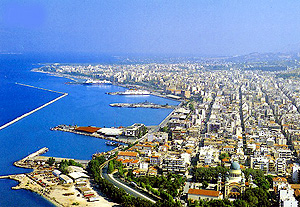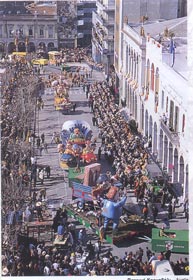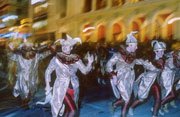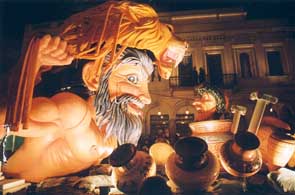| HOME |
|
HISTORY OF
PATRAS |
|
The
city |
The
Carnival |
Useful
numbers |
|

Patras, one of the busiest cities in Greece because of
its cluster of University faculties, is the capital of Achaia
Prefecture. It is named for Patreus, legendary chief of the
Achaeans.
It is the largest city in the Peloponnese, and has the fourth
largest population in Greece (160,000), following Athens, Piraeus
and Thessaloniki.
As the biggest port in Western Greece, it is an important
communications hub, connecting Greece with Italy, and the
Peloponnese with the Ionian Islands.
The city extends from the sea front to the foot of mount
Panachaiko.
Patras is divided into two urban districts: the Upper Town and the
Lower Town. The Lower Town is conspicuous for its symmetrical
street-plan and its many squares.
The Upper Town, which is the old part below the Venetian castle,
has numerous neoclassical buildings. The Lower Town also has a
number of period buildings by some famous architects. One of the
most typical of these is the Municipal Theatre by Ziller. There
are also buildings by, among others, Kleanthis.
The cathedral and pilgrim church of Agios Andreas (St
Andrew), patron saint of Patras, is at the south-west entrance
to the Lower Town. Beside it is an older church replacing a
Byzantine church razed by the Turks
.
The pedestrianised street of Trion Navarchon leads to Psila
Alonia, a large and beautiful square with palm trees and a
sundial.
The city has an Archeological Museum with important fidnings from
excavations; a Municipal Library; and a Press Museum.
Above the city tower the ruins of the Venetian Castle, now a
public gardens from which there is a fine panoramic view across
the city and the Gulf of Corinth to the coast of Midland Greece (Sterea
Ellada) opposite.
Quiet coffee houses, outdoor restaurants of every description,
busy local traffic, visitors form abroad and people passing
through – such is the atmosphere of this beautiful city.
The world-famous Patras Carnival in early spring is a specimen of
local imagination, humor and cheerfulness. It attracts thousands
of visitors every year.
THE
PATRAS CARNIVAL |
 |
 |
 |
|
The Patras Carnival is the biggest event of its kind in the
country. It is also in certain respects one of the biggest
carnivals in the world and one of the most important in Europe.
It has been held for more than 160 years and its origins date to
the start of the 19th century, when the first shrovetide ball is
said to have been hheld at the house of a merchant called Meretis.
It was in the 1860s that a formal Patras Carnival as such was
held. Undoubtedly one of the reasons for this was the union of the
Ionian Islands with Greece, bringing in Italian and and
Ionian traditions, though the event has also absorbed influences
from many places in the Mediterranean and elsewhere. But Greek
elements and local culture have always predominated.
The Carnival has gone through many shapes and stages. The start of
its career in recent times has been taken to be the year 1966.
This was when the Treasure Hunt was introduced – still a very
popular event attracting some 50,000 young participants from
Patras. The hunt, essentially a simple navigational game, has
become, thanks to the inhabitants’ inventiveness, the core
carnival lasting ten days or more, with its famous Parade.
The carnival events, starting on 17 January every year and lasting
until Ash Monday, are either programmed by the Municipal Committee
of Carnival Events, or planned by the citizens and supported by
the spontaneity, the inspiration and the creative ability of the
inhabitants of Patras themselves. The carnival is enriched yearly
with new events with the last carnival Sunday Parade continuing to
be the dominant attraction. However, the Carnival events are not
only the Parade but also the continuous dancing of thousands
participants who disguised and organised in groups flood the city
streets dancing in frenetic rhythms.
The ‘Bourboulia’ famous ball is organised by the Municipality
at Patras Municipal theatre APOLLON (an architectural creation of
Ziller in 1872, a mini-reproduction of the Milan Scala Opera
House). At ‘Bourboulia’ women wearing black dominoes and masks
dominate and control men who participate in their everyday
clothes. Entrance for dominoes is free while men have to pay.
The carnival events end on the night of Carnival Sunday with the
burning of the Carnival Man. Ash Monday, with a kite-flying
competition, concludes the month and a half long fun, although in
some places the dancing goes on.
BASIC
FACTS AND FIGURES - PATRAS
Population: 200.000
Telephone: area code 2610, country code 30
Weather: weather up-dates are available
at
http://www.hnms.gr/emy/english/ath2004/index_html
|
|





